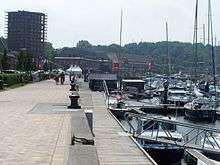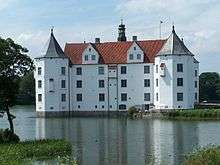Flensburg
Flensburg (Danish: Flensborg) is a city in Schleswig-Holstein located on the east coast. The 85000 inhabitants live around the Flensburger Förde (Flensborg fjord). Its main claim to fame besides being a border town is the fact that the central registry for traffic offenses committed throughout Germany is headquartered in Flensburg.
Get in
By car
Most people arrive here by car. Flensburg is situated at the border of Germany and Denmark, beside the motorway ![]()
![]()
By bus or train
- 🌍 Flensburg station.
There are bus and train connections both from Denmark and Hamburg. Search Bahn.de for public connections in Germany, and DSB for Denmark.
By plane
The nearest airports are Hamburg (HAM IATA) about 150 km (93 mi) away offering a wide array of flights to domestic and international destinations and Sønderborg (SGD IATA, in Denmark 50 km (31 mi) away; flights from Copenhagen only). Hamburg airport is served by the Hamburg S-Bahn and from Hamburg main station direct RE and Intercity trains leave for Flensburg with a travel time a bit under 2 hours. From Sonderborg airport take a taxi to the rail station and then DSB train.
See
Flensburg offers a nice shopping district with old houses and gardens as well as a variety of museums and churches. The harbour is the hosting place for sailing regatta and events.
Museums
- Museumsberg Flensburg: a museum on a hill in the center of Flensburg exhibiting local history artefacts and art by not only local artists. On Fridays entry is for free, otherwise varying between €4.00 and €0.50. It is closed Mondays; otherwise it is open from 10-4 (November to March) or 10-5 (May to October).
- Naturwissenschaftliches Museum und Eiszeit-Haus (Science Museum and Ice Age House): located on the museum hill next to the other museum; same opening times; entry is free.
- Phänomenta: an interactive science museum, where you can try experiments on you own, especially interesting for families and children and anybody interested in science. Prices vary from €9.50 for adults to €7.00 for youth and €2.00 for children. Opening times on weekdays are 9-5 (October to May) and 10-6 (July to September) and 11-6 on weekends.
- Museumswerft (Shipyard museum): this museum shows and builds old ships and boats and offers courses for children, teenagers and adults. Free entry, open from 8-5 (weekdays) and 10-5 (weekends). Tours are available when booked in advance. It is located directly on the harbour.
- Wehrgeschichtliche Ausbildungszentrum: a naval museum in the famous Naval Academy Mürwik. On the edge of it ended the Third Reich. The naval museum is open on Tuesdays from 2 o'clock p.m. to 7 o'clock p.m. Entry is free but visitors must show their identity cards.
Churches
The following churches have an interesting architecture and are located in the old centre of Flensburg. Click http://www.flensburg-online.de/kirchen/index.html for an (almost) complete list of churches in Flensburg.
- 🌍 St. Nikolai (Lutheran).
- 🌍 St. Marien (Lutheran).
- 🌍 St. Johannis (Lutheran).
- St. Marien, schmerzhafte Mutter (Roman Catholic).
- 🌍 Helligåndskirken (Church of the Holy Spirit, Danish church, Lutheran).
Other important Churches are the Lutheran Church St. Jürgen which is an typical photo subject. The Church is goood to see from the harbour on the eastern shore. An Garrison Church, with the name Christuschurch, is located in the borough Mürwik (Muerwik). The Christuschurch owns a beautiful triumphal cross from the 16th century.
Architecture
- One of the oldest buildings in the city is the building of the "Nikolai-Apotheke" at the "Südermarkt", an old marketplace. The building was built in the 15th century. The architecture inside as well as outside is very much worth visiting.
- The Naval Academy Mürwik is a castle for the German Navy which was built in 1910 by the German Emperor Wilhelm II. Pattern for it was the Marienburg, the Castle of the Teutonic Order, which lays today in the polish town Malbork.
- The Sportschool in the borough Mürwik was built in 1936/37. In May 1945 it was the seat of the Flensburg Government. The government was formed after the suicide of Adolf Hitler. Head was Grand Admiral Karl Dönitz.
Do

Tours around the city can be booked at the tourist information center in the old town center.
- Tourism Agency, Rote Straße 15-17 (the address is Rote Straße, but the door is in the street Klostergang), ☎ +49 461 9090920, fax: +49 461 9090936, e-mail: info@flensburg-tourismus.de.
A nice way to enjoy the maritime atmosphere of Flensburg is to take a tour on one of the 5 different ferries.
- Alexandra, ☎ +49 461 212-32. The Alexandra just celebrated her 100th birthday and is so the oldest passenger stream boat which is still in use in whole Germany.
- MS Viking, ☎ +49 174 15 85 555.
- MS Möwe, ☎ +49 461 62-945.
- MS Flora II, ☎ +49 177 55 11 114.
- MS Feodora, ☎ +49 172 45 16 791.
Buy

Lots of people arrive in Flensburg from Denmark and the other Nordic countries for shopping. In the old centre of Flensburg are numerous shops along the pedestrian street Holm (Danish: Holmen) and Große Straße and inside the new shopping mall Flensburg Galerie. Certainly a nice place to visit in the centre is the famous "Rote Straße" (Red Street). As part of the traditional "Ochsenweg" the Rote Straße represents a big part of Flensburg's history. Many little shops can be found there. The borough Mürwik (Muerwik) owns also an separate little centre, named Twedter Plack. The centre is on the edge of the military where also located is the Naval Academy Mürwik.
In addition to the numerous small shops in the old centre of the town there's a shopping centre some 2 km south of the city, Förde Park as well as Poetzsch at Kupfermühle near the Danish border. Other shopping centres are Scandinavien Park and Citti Park. The Scandinavian Park in the suburb Handewitt is conveniently located right off the northernmost exit of A7 motorway in Germany. Due to its location and tourists visiting it is allowed to open all week long and attracts locals from both sides of the border, who go there for a Sunday grocery run. Price differences between Denmark and Germany may make a certain item a bargain for Danish people but it might be expensive for Germans.
Eat
- Dionysos, Glücksburger Straße 174, ☎ +49 461 140-800. A Greek restaurant in the first floor of Hotel Fruerlund.
- Marien-Café, Norderstrasse 13, ☎ +49 461 500-9711.
- Goldene Lilie, Angelburger Straße 10-16 (opposite of the side entrance of the Fensburg Galerie), ☎ +49 461 26294, fax: +49 461 1505443. 11:30am-3pm and 5:30pm-11pm. A Chinese restaurant offering a tasty buffet and a good menu.
- Galerie, Holm 66 (located in a garden, opposite the Holm). A restaurant offering a variety of pizza and pasta, non-vegetarian and vegetarian food.
Drink
Sleep
%2C_Bild_02.jpg)
- Hotel am Wasserturm, Blasberg 13, 24943 Flensburg (The hotel is situated in Flensburg-Mürwik. There are signs showing the way to the hotel.), ☎ +49 461 3150600, e-mail: info@hotel-am-wasserturm.com.
- Hotel Seewarte, Mürwikerstrasse 164, 24944 Flensburg, ☎ +49 461 35 0 25, fax: +49 461 31 22 87. Check-in: 14-21, check-out: 7-12. Inexpensive hotel outside the city center. Not without reason sometimes compared to British comedy "Fawlty Towers", but the staff is very kind and helpful. No credit cards accepted €35-50.
- Hostel Flensburg, Zur Exe 23, ☎ +49 461 90 90 833, fax: +49 4619090834. Check-in: 4pm-9pm, check-out: till 12pm.
- Jugendherberge Flensburg, Fichtestraße 16, 24943 Flensburg, ☎ +49 461 37 74 2.

Go next
- Glücksburg Castle (just outside Flensburg). Beautiful old white castle. 5 €.
- Kiel
- Lübeck
- Hamburg
- Schleswig
| Routes through Flensburg |
| Aalborg ← Åbenrå ← | N |
→ Rendsburg → Hamburg |